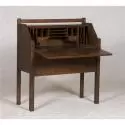A Missing Piece in a Mission Oak Puzzle

The best part of writing isn’t leaning back and hitting Save.
It isn’t seeing what you wrote appear in print.
It isn’t knowing your work is appreciated.
It’s the research.
In 1946 my father came back from his tour of duty aboard the battleship the U.S.S. Chevalier and soon started his own business in a corner of our dining room with a second-hand mission oak dropfront desk. When he replaced it several years later with a larger oak roll top desk, he gave me his small dropfront desk, which I had always loved for its fitted interior with several slots, narrow compartments and two small drawers.
And which, at age 10, I promptly defaced by affixing baseball card decals all over the quartersawn front: National League on the left, American League on the right.
(Yes, I see the irony: me defacing a desk with decals – and it gets worse….)
Years later, I righted my first wrong with yet another: I refinished it, stripping off the decals, along with the original finish and most of the dark aniline dye. It was the Seventies and I was into Golden Oak, so I stripped and sanded and sanded and sanded as much of that dark dye as I could get out of the pores of the wood. When I was finished, it was, too – at least as an original Arts & Crafts desk.
My dad’s desk has moved with me a total of ten times in forty years. And over time the glossy Golden Oak has mellowed to an acceptable late-Arts & Crafts hue. Once I got hooked on Arts & Crafts I continued to lament the fact that my enthusiastic refinishing had destroyed the original label that would have told me who made my father’s desk. Family lore had credited a local cabinetmaker, but my experience soon taught me to recognize the signs of factory production — machine-cut dovetails, model numbers scrawled on the back, precision-cut tenons.
But which firm?
As much as I would have loved for it to have come out of East Aurora or Syracuse, I knew it had not been made by either the Roycrofters or any of the Stickleys, including Charles or Albert. But it had been my father’s desk and that was by far more important.
Then, a few weeks ago, as I was utilizing the internet to research some obscure Arts & Crafts furniture makers whose shopmarks we wanted to include in our collection here, I stumbled upon it: my father’s desk.
Now, I’m not talking “close to” or “sorta like” or even “just like except for….”
It was my father’s desk, right down to the exact dimensions and the cubbyholes and the hammered copper pull on the dropfront lid. It had recently been sold at auction by a firm that posted the contents of their sale online. Not only did they include a picture of it, they provided a detailed description that matched my father’s desk perfectly.
Along with a red oval label.
The Cron-Kills Company in Piqua, Ohio.
Named, it appears, by two of its founders, A. J. Cron and Robert B. Kills. At one time they employed 275 men who produced wardrobes, armoires, dining room furniture and dropfront desks, which during that era the industry called “ladies’ desks.”
Suddenly my father’s desk had a heritage. How it got from Piqua, Ohio, to New Windsor, Illinois, I may never know, but it had and that was all that mattered.
It was, by the way, the only piece of Arts & Crafts furniture my parents ever owned. As my father once remarked when he saw my first house furnished in Arts & Crafts, “During the Depression, if you had mission oak, it meant you were poor.”
The way most of us collect today, it still does.

Until next Monday,
Have a great week!
Bruce
